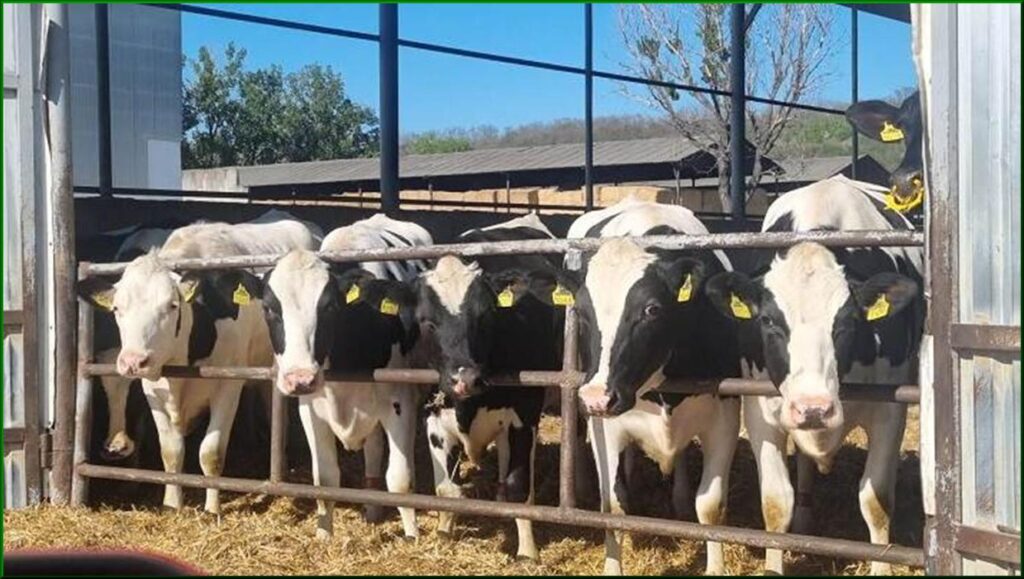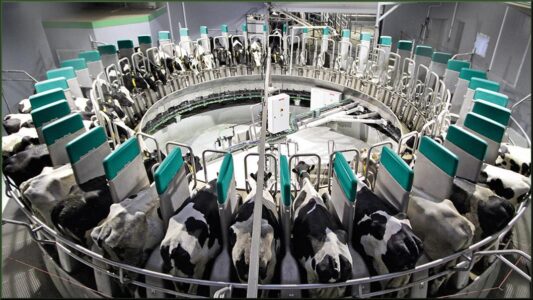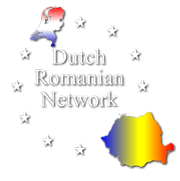Importance of livestock

The authors describe livestock farming as playing an essential role in ensuring food security in the EU, maintaining economic balance in rural areas and providing value-added food products. According to Eurostat data (2023), livestock production accounts for about 40% of the total value of agricultural production in the EU-27, and dairy cattle are a central pillar of this ecosystem, with more than 20 million head raised on commercial farms.
Countries such as Germany, France, the Netherlands and Poland stand out for their high efficiency, superior yields per animal and advanced agricultural technology. For example, average milk production in Germany and the Netherlands exceeds 9,000 liters per animal per year, while the European Union average is around 7,300 liters per animal per year (European Milk Market Observatory, 2023). These results are due to continuous investments in genetics, nutrition, automation and digitalization.
Lagging behind in competitiveness
In contrast, Romania, although endowed with significant natural resources, is struggling to become more competitive and achieve similar results. Although the cattle sector has stabilized in recent years, it is still characterized by low levels of economic concentration and  low technological efficiency. Data from the National Institute of Statistics (INS, 2023) show a decline in the cattle population from 2.5 million head in 2007 to about 1.85 million in 2023, of which only about 20% are kept on commercial farms. Average milk production per animal is between 4,000 and 5,500 liters per year – significantly lower than the European average. Technical gap
low technological efficiency. Data from the National Institute of Statistics (INS, 2023) show a decline in the cattle population from 2.5 million head in 2007 to about 1.85 million in 2023, of which only about 20% are kept on commercial farms. Average milk production per animal is between 4,000 and 5,500 liters per year – significantly lower than the European average. Technical gap
Unfortunately, one of the most visible differences between Romania and Western European countries is the level of technical equipment. According to a report by the Ministry of Agriculture and Rural Development (MADR, 2022), only 15-18% of commercial dairy farms in Romania use automated milking systems and less than 10% have microclimate monitoring equipment. In contrast, in Germany, the Netherlands and Denmark, digitization of all processes – including herd management, automated ventilation and feed monitoring – is already common practice on medium and large farms.
Competitive Advantages
However, according to the authors, Romania has competitive advantages that, with a coherent valorization strategy, can be turned into sources of progress. These include: the availability of large fodder resources (13 million hectares of arable land), relatively low labor costs, access to European funds and the growing demand for local dairy products with guaranteed traceability. To convert these advantages into real economic benefits, the process of technological modernization must be accelerated. Structural challenges
If we dig deeper into the challenges Romanian farmers face, they are multiple and structural in nature. The small size of farms, low capitalization rates, insufficient use of technology and limited access to digital innovations significantly limit their competitiveness.
Romania represents about 33.5% of the total number of farms in the EU, but most of these are small, with an average size of 4.4 ha/farm, compared to the EU average of 15 ha/farm (Eurostat, 2023). This fragmentation reduces economic efficiency and makes it difficult to attract significant investment. For example, an average farm in France or Germany has more than 100 dairy cows and uses automated equipment, while Romania has more than 134,000 small dairy farms (less than 10 head), many of which are below the profitability threshold (MADR, 2022).
A comparison with the EU
Overall economic performance confirms these differences. A study published in the journal “Sustainability” (2023) compared key indicators between EU countries and showed that Romanian farms have a Farm Economic Sustainability Index (FESI) of €29,262, compared to the EU average of €41,529. Regarding the Farm Capitalization Index (FCI), Romania stands at 13.8, while the European average is 18.96 – indicating significant differences in technical equipment. Similarly, the Profitability and Cash Flow Index (PCFI) in Romania ranges between 118% and 136%, lower than the level in other countries (137%-157%), indicating lower liquidity and limited self-financing capacity.
Digitization
The level of digitalization is also a critical factor. Only 15-18% of commercial cattle farms in Romania use automated milking equipment and less than 10% have microclimate monitoring systems, while in countries such as Germany or the Netherlands these technologies are present on more than 60% of farms. In addition, tractor density is another relevant indicator: in Romania, there is 1 tractor per 54 ha, compared to 1 tractor per 13 ha in Western European countries, indicating low productivity and high dependence on manual labor (European Commission, 2022).
The digitization process is also delayed by cultural and institutional factors. Research highlights the main obstacles faced by small farms in Romania in implementing Agricultural Digital Solutions (ADS): high initial costs, lack of digital skills and insufficient institutional support. Studies show that Romanian farmers’ reluctance to implement smart technologies is influenced by low levels of technical education, but also by the lack of functional local examples that drive change. Market position of farmers
Moreover, market positioning is often unfavorable. Large farms in Western Europe are integrated into efficient processing and distribution networks, while most farmers in Romania sell milk as a commodity at low prices, with no processing capacity of their own. This dependence limits the added value farmers achieve and increases their vulnerability to market fluctuations.
Financial position
In terms of financial support, Romania is also not in a favorable position. The ratio of subsidies to income is 107%, lower than the EU average of 121%. In fact, less than 30% of European funds are converted into productive investments, compared to more than 45% in farms in developed countries.
Conclusion: the only way is up!

The authors conclude that all these structural, technological and differences lead to unequal competition within the EU market. Without a coherent modernization plan, Romanian farmers risk being stuck in an uncompetitive economic model vulnerable to external shocks and unable to meet increasingly stringent quality, safety and sustainability standards. For the new Romanian government, the livestock sector is a priority. We continue to monitor and examine developments in this and other promising sectors, and identify opportunities for cooperation between NL and RO.
Curious about the opportunities on the Romanian market? See also: Agrifood Trade Mission to Romania (Initiative Romanian Embassy Bucharest (ask for Sophie Neeve)and ‘Dutch Day at Indagra Fair’ and maybe you will manage to speak there the experience experts Peter and Jan de Boer of DN Argrar
